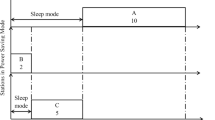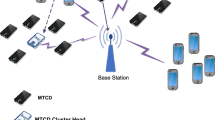Abstract
With the new IEEE 802.11ah standard aimed at improving the existing WLAN standard for the machine-to-machine applications, there is a renewed interest from the research community to analyze and suggest improvements to the standard. With thousands of smart devices and sensors involved in an internet of things network, the interference from multiuser access becomes a serious issue. This paper presents an access point (AP) coordinated multiuser access mechanism for such applications, where the strategy to improve channel usage efficiency is based on analyzing interference present in the neighborhood. Interference experienced in such a system is a function of node location, transmitted power, traffic load and resource allocation. In our proposed system, each WLAN AP from the overlapping basic service sets employs multiple frequency sub-bands and associates user nodes to these sub-bands dynamically. We show that this proposed interference-aware dynamic frequency allocation (IDFA) scheme, which is based on neighborhood contention analysis, can significantly enhance the system throughput and improve the energy efficiency by about 30%. In dense user node deployments, the channel access efficiency of the IDFA multi-band scheme is 2–3 times higher than that of the single band legacy WLAN.














Similar content being viewed by others
Explore related subjects
Discover the latest articles and news from researchers in related subjects, suggested using machine learning.Notes
The edges of the graph may intersect depending on the node transmission power. The interference analysis in this section will not be affected by this change.
References
Raza, U., Kulkarni, P., & Sooriyabandara, M. (2017). Low power wide area networks: An overview. IEEE Communications Surveys Tutorials, 19, 855–873 [Secondquarter (2017)].
Morin, E., et al. (2017). Comparison of the device lifetime in wireless networks for the internet of things. IEEE Access, 5, 7097–7114.
IEEE approved draft standard for information technology-telecommunications and information exchange between systems-local and metropolitan area networks-specific requirements-part 11: Wireless LAN medium access control (MAC) and physical layer (PHY) specifications: Amendment 2: Sub 1 GHz license exempt operation. IEEE P802.11ah/D10.0, September 2016, pp. 1–660 (2016).
Adame, T., et al. (2013). Capacity analysis of IEEE 802.11ah WLANs for M2M communications. In Proceedings of the 6th international workshop on multiple access communcations—Volume 8310, MACOM 2013, New York, NY, USA (pp. 139–155). New York: Springer.
Tian, L., Famaey, J., & Latre, S. (2016). Evaluation of the IEEE 802.11ah restricted access window mechanism for dense IoT networks. In 2016 IEEE 17th international symposium on a world of wireless, mobile and multimedia networks (WoWMoM) (pp. 1–9).
Raeesi, O., et al. (2014). Performance evaluation of IEEE 802.11ah and its restricted access window mechanism. In 2014 IEEE international conference on communications workshops (ICC) (pp. 460–466).
Wang, Y., et al. (2015). Energy-aware adaptive restricted access window for IEEE 802.11ah based smart grid networks. In 2015 IEEE international conference on smart grid communications (SmartGridComm) (pp. 581–586).
Park, C. W., Hwang, D., & Lee, T. J. (2014). Enhancement of IEEE 802.11ah MAC for M2M communications. IEEE Communications Letters, 18, 1151–1154.
Zheng, L., et al. (2014). Performance analysis of group-synchronized DCF for dense IEEE 802.11 networks. IEEE Transactions on Wireless Communications, 13, 6180–6192.
Chang, T. C., et al. (2015). Load-balanced sensor grouping for IEEE 802.11ah networks. In 2015 IEEE global communications conference (GLOBECOM) (pp. 1–6).
Khorov, E., Krotov, A., & Lyakhov, A. (2015). Modelling machine type communication in IEEE 802.11ah networks. In 2015 IEEE international conference on communication workshop (ICCW) (pp. 1149–1154).
Malone, D., Duffy, K., & Leith, D. (2007). Modeling the 802.11 distributed coordination function in nonsaturated heterogeneous conditions. IEEE/ACM Transactions on Networking, 15, 159–172.
Boroumand, L., et al. (2012). A review of techniques to resolve the hidden node problem in wireless networks. Smart Computing Review, 2(2), 95–110.
Dong, M., Wu, Z., Gao, X., & Zhao, H. (2016). An efficient spatial group restricted access window scheme for IEEE 802.11ah networks. In 2016 sixth international conference on information science and technology (ICIST) (pp. 168–173).
Park, M. (2014). IEEE 802.11ah: Energy efficient MAC protocols for long range wireless LAN. In 2014 IEEE international conference on communications (ICC) (pp. 2388–2393).
Qiao, D., Choi, S., & Shin, K. G. (2007). Interference analysis and transmit power control in IEEE 802.11a/h wireless LANs. IEEE/ACM Transactions on Networking, 15, 1007–1020.
Kwon, H., et al. (2009). Generalized CSMA/CA for OFDMA systems: Protocol design, throughput analysis, and implementation issues. IEEE Transactions on Wireless Communications, 8, 4176–4187.
Khorov, E., et al. (2015). A survey on IEEE 802.11ah: An enabling networking technology for smart cities. In Computer communications (Vol. 58, pp. 53 – 69). Special issue on networking and communications for smart cities.
Makhlouf, A. B., & Hamdi, M. (2014). Dynamic multiuser sub-channels allocation and real-time aggregation model for IEEE 802.11 WLANs. IEEE Transactions on Wireless Communications, 13, 6015–6026.
Wu, H., Peng, Y., Long, K., Cheng, S., & Ma, J. (2002). Performance of reliable transport protocol over IEEE 802.11 wireless LAN: Analysis and enhancement. In Proceedings twenty-first annual joint conference of the IEEE computer and communications societies (Vol. 2, pp. 599–607).
Li, L., Pal, M., & Yang, Y. R. (2008). Proportional fairness in multi-rate wireless LANs. In IEEE INFOCOM 2008—The 27th conference on computer communications.
Kim, S., Choi, S., Kim, Y., & Jang, K. (2008). MCCA: A high-throughput MAC strategy for next-generation WLANs. IEEE Wireless Communications, 15, 32–39.
Serrano, P., Patras, P., Mannocci, A., Mancuso, V., & Banchs, A. (2013). Control theoretic optimization of 802.11 wlans: Implementation and experimental evaluation. Computer Networks, 57(1), 258–272.
Hazmi, A., Rinne, J., & Valkama, M. (2012). Feasibility study of IEEE 802.11ah radio technology for IoT and M2M use cases. In 2012 IEEE globecom workshops (pp. 1687–1692).
Pandya, B., Chuang, F.-K., Tseng, C.-H., & Chiueh, T.-D. (2017). An energy-efficient communication system using joint beamforming in multi-hop health monitoring sensor networks. EURASIP Journal on Wireless Communications and Networking, 2017, 172.
Acknowledgements
This work is supported in part by the Ministry of Science and Technology (MOST), Taiwan under Grant MOST104-2221-E-002-075-MY2.
Author information
Authors and Affiliations
Corresponding author
Rights and permissions
About this article
Cite this article
Pandya, B., Chiueh, TD. Interference aware coordinated multiuser access in multi-band WLAN for next generation low power applications. Wireless Netw 25, 1965–1981 (2019). https://doi.org/10.1007/s11276-018-1790-4
Published:
Issue Date:
DOI: https://doi.org/10.1007/s11276-018-1790-4




